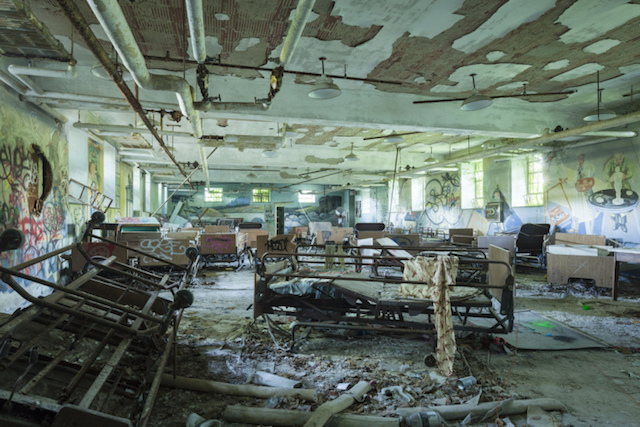As you may know from last year’s Abandoned NYC video on Long Island’s own Kings Park Psychiatric Center, the words ‘abandoned psychiatric hospital,’ usually conjure up visions of frontal lobotomies, electroshock therapy, and other archaic treatments for mental illness. But underneath the pure shock value that commands most of our attention was a real cultural dilemma, and an underrepresented branch of American history that deserves a proper light.
This is the goal of filmmaker Mark Burkhalter and the producers of Project Senium, whose two films cover the grounds of Kings Park, a former state-run psychiatric hospital whose occupancy once exceeded 9,000 patients in 1954 but was closed for good and abandoned in 1996. ‘Project Senium’ and Burkhalter’s ‘Kings Park: The Abandoned City’ delve deep into a few of its over 100 buildings and explore its shrouded past.
The Kings Park Psychiatric Center, called the Kings County Asylum when it was founded and known by locals as simply “the psych center,” opened in 1885, a revolutionary facility that hoped to solve New York City’s enormous hospital overcrowding problem. Founded as a farm colony in which patients would learn agrarian skills and manage the sprawling hospital’s grounds, Kings County Asylum was for hospital officials to be a step away from existing mental health facilities with too many patients and numerous accusations of abuse.
With “The Abandoned City,” Mark Burkhalter aims to understand the psychiatric center’s troubled past. The 25-minute documentary deals extensively with Kings Park’s background and the events leading up to its post-WWII expansion as well as its closing in the late 90s. The video is also a catalog in part of the building’s grounds, with looks into some of the lesser-known buildings as well. Due to the center’s size, which kept growing ever since Kings Park’s founding in the 19th century, Burkhalter calls the place a city, built to sustain an entire population.
Deviating slightly from “The Abandoned City,” the aim of Project Senium’s video is centered around the center’s aesthetic, adopting a markedly more cinematic feel and focusing on the beauty of Kings Park’s abandonment and current state. As stated in the website’s background information, the video is “an effort to preserve the experience of some of the most beautifully disturbing places in the world.”
Over time, Kings Park was expanded and for much of its early years seemed a success. Additions like the 13-story Building 93 and what would become the recreational Buckman Day Treatment Center were made possibly due to the hospital’s growing occupancy. In the aftermath of World War II, the psychiatric center’s occupancy reached its peak, and its relaxation-based agrarian approach to treating mental health was substituted for more invasive forms of treatment: the pre-frontal lobotomies and aversion therapy techniques that have since become a playground for horror enthusiasts; see 2012’s Fox TV-series ‘American Horror Story: Asylum,’ set in a 1960s mental health facility inspired in part by Kings Park, for proof.
The psychiatric center closed with an understandably sour reputation, and is regarded by some as haunted due to its sinister history.
However, in recognizing and learning from the trial and error of treating mental health and the effect it has had on the Kings Park grounds, “The Abandoned City” and “Project Senium” highlight a truth about the center, that despite its dark history, there is something of value to those who go there.
To this day, the grounds are technically ‘open,’ though both Burkhalter and Project Senium warn that entering the facility is not to be taken lightly. Whether that has stopped anyone from trekking to Long Island to see Kings Park for themselves is, unfortunately, unclear.
See more photos at Abandoned NYC. Get in touch with the author at @jinwoochong.






